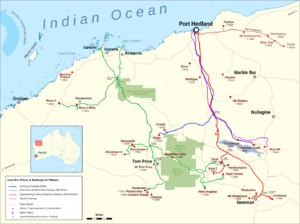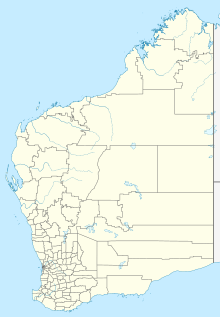Firetail mine facts for kids
| Location | |
|---|---|
| Location | Shire of Ashburton, Pilbara |
| State | Western Australia |
| Country | Australia |
| Coordinates | 22°07′25″S 117°54′51″E / 22.1236°S 117.9143°E |
| Production | |
| Products | Iron ore |
| Production | 27 million tonnes/annum |
| History | |
| Opened | 2013 |
| Owner | |
| Company | Fortescue Metals Group |
| Website | Fortescue website |
The Firetail mine is a big iron ore mine in Western Australia. It is run by a company called Fortescue Metals Group (FMG). You can find it in the Pilbara region, about 60 kilometers north of Tom Price. The Firetail mine is part of a larger mining area called the Solomon Hub. FMG has two other main mining areas too: the Chichester Hub and the Western Hub.
Contents
What is the Firetail Mine?

The Firetail mine digs up iron ore, which is a rock used to make steel. Steel is super important for building things like cars, bridges, and tall buildings. This mine is a key part of how Australia provides iron ore to the world.
Working with Traditional Owners
The Firetail mine is on the traditional lands of the Yindjibarndi people. They are the original owners of this land. For many years, there was a disagreement between the Yindjibarndi people and Fortescue Metals Group. This was about how the mining would affect their land and what kind of agreement they would have.
In 2020, after a long legal process, the High Court of Australia made a decision. They ruled in favor of the traditional owners. This helped to settle the disagreement.
When Did Mining Start?
Fortescue Metals Group asked for permission to start the Solomon iron ore project in 2011. This project included the Firetail mine and another mine called Kings Valley. It also involved building a new railway line.
The Firetail mine officially opened on May 6, 2013. A government minister, Bill Marmion, was there for the opening. However, mining had actually begun a little earlier, in late 2012. The first iron ore from Firetail was sent by train in December 2012.
How Much Ore Does it Produce?
When it first opened, the Firetail mine was planned to produce 20 million tonnes of iron ore each year. The nearby Kings Valley mine was expected to produce even more. Together, the Solomon Hub was planned to produce 60 million tonnes of iron ore every year.
By late 2016, the Firetail mine was producing about 27 million tonnes of iron ore per year. This high-quality ore was important for mixing with other types of ore from FMG's mines.
Future Plans
The Firetail mine was expected to run out of ore by 2019. So, in 2018, FMG decided to build a new mine called the Eliwana mine. This new mine is meant to take the place of the Firetail mine.
In 2021, mining at the Solomon Hub was briefly paused because of a serious incident.
Other Mines in the Area
Besides the Solomon Hub, Fortescue Metals Group has other active mining areas.
Chichester Hub
The Chichester Hub includes the Christmas Creek and Cloudbreak mines. These are also important iron ore mines.
Western Hub
The Western Hub currently has the Eliwana mine. This is the newer mine that will help continue iron ore production.
Queens Valley Mine
A third mine within the Solomon Hub, called the Queens Valley mine, was approved in 2019. It is located about 15 kilometers west of the Kings Valley mine. This new mine is expected to open in 2022.


